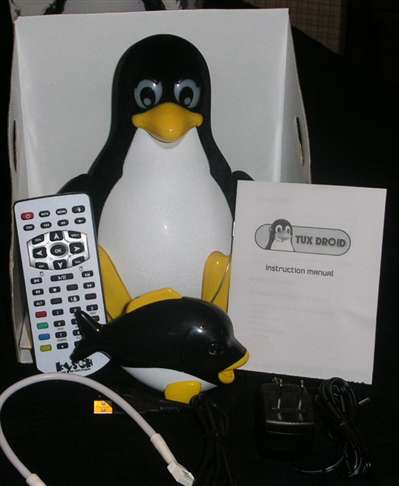Falling in love with flightless fowl
 Tux Droid
Tux Droid
Developer: Kysoh
Platform: Linux
Price: $99
Linus Torvalds, the creator of the open-source Linux kernel, was once mauled by a very small penguin while on a trip in Australia. The experience had a lasting impact on him and later inspired him to make a penguin the official Linux mascot. Developer Larry Ewing created the first graphical rendering of the Linux penguin, which countless Linux users around the world know today as Tux.
An electronics company called Kysoh aims to bring the Linux mascot to life with a unique programmable toy. The Kysoh Tux Droid is a robot that wirelessly connects to a Linux computer (no Windows or Mac OS X support yet) and performs actions in response to preprogrammed events. It can flap its wings, turn around in circles, blink, detect light levels, record audio, and even speak. The Tux Droid also comes with an IR remote that can be used to make it do your bidding... until the grim day when it achieves complete autonomy and throws off the shackles of human subjugation, conspiring with the devious Roomba collective in an insidious plot to overthrow humanity.
Tux swims out of the box
The Tux Droid comes with a USB cable, an IR remote, a white firmware update cable, a power adapter, a concise instruction manual, and a 2.4 Ghz wireless dongle shaped like a fish that plugs into a standard USB port on the host computer and facilitates communication between the computer and the robot.
After extricating it from the packaging, a close examination reveals that soft fuzz covers most of its exterior, except for the plastic beak, feet, and eyes; it's approximately eight inches tall and rests steadily on three wheels that come out of the bottom. The build quality is pretty solid, but I don't think it would survive a fall from a high shelf onto a hard floor. The overall appearance is good—it is an unmistakable likeness of Ewing's original Tux rendering, and in person, any Linux enthusiast would recognize it as Tux at a glance.
Setting up Tux
The initial setup process is relatively straightforward. I started by plugging in the Tux Droid and turning it on. It has an internal rechargeable battery and can function on power from a regular wall socket while charging. When the droid activates, it says hello and flaps its wings.
Next, I plugged the fish dongle into the USB port on my keyboard. A blue LED will blink slowly behind its eyes to indicate that it is receiving power and attempting to establish a connection. When the fish finishes connecting with the Tux Droid (this typically doesn't take very long), the LED inside the fish will blink more rapidly and the LEDs behind Tux's eyes will turn solid blue.
The last setup step is installing the software so that Tux can be controlled from the computer. This control software isn't included in the box with the droid, so it has to be downloaded from the Internet... and that's where I ran into my first problem. The Kysoh web site is a bit disorganized, and it took me a few minutes to figure out that the required software is actually available for download from the Tux Droid community site rather than Kysoh's official web site as the instruction manual had indicated. In addition to the software itself, the community site also has a wiki page with more complete installation instructions.
The software is available in a Debian package or a tarball. I chose the Debian package, which can be installed on Ubuntu and other Debian-based Linux distributions by double-clicking the package file in a file manager or by using the dpkg command at the command line. I also had to install the text-to-speech voice package in order to get Tux to talk. The voice files are also distributed in both deb and tarball formats, and are available in 11 different languages. The most recent version of the Tux Droid software is 1.2.2, which was released in January.
The control software itself consists of several daemons (one for text-to-speech support and one for enabling interaction with the robot), a few graphical control utilities, and various custom behavior programs called gadgets. After installing the packages, I had to reboot my computer to get the Tux software daemons to start.



reader comments
0